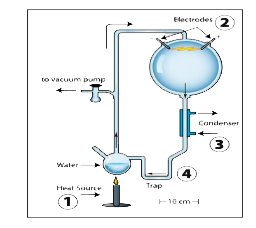S.L. Miller an American scientist created electric discharge experiment in a closed flask containing CH4,H2,NH3 and water vapour at what temperature?
400∘C
800∘C
200∘C
1000∘C
The correct Answer is:B
To answer the question regarding the temperature at which S.L. Miller conducted his electric discharge experiment, follow these steps:
1. Identify the Experiment: Understand that S.L. Miller performed an experiment to simulate the conditions of primitive Earth to investigate the spontaneous formation of organic compounds.
2. Components of the Experiment: Recognize that the closed flask contained gases such as methane (CH₄), hydrogen (H₂), ammonia (NH₃), and water vapor.
3. Temperature Setting: Recall that the experiment required a specific temperature to mimic the conditions of early Earth.
4. Determine the Temperature: From the information provided, it is noted that the temperature at which Miller conducted his experiment was around 800 degrees Celsius.
5. Select the Correct Option: Based on the temperature identified, the correct answer to the question is 800 degrees Celsius.
Thus, the answer is: 800 degrees Celsius.
---
Topper's Solved these Questions
- ORIGIN & EVOLUTION OF LIFEBOOK - ALLENCHAPTER - ORIGIN & EVOLUTION OF LIFEEXERCISE - EXERCISE-III A(NCERT BASED QUESTIONS)
70 Videos
- ORIGIN & EVOLUTION OF LIFEBOOK - ALLENCHAPTER - ORIGIN & EVOLUTION OF LIFEEXERCISE - EXERCISE-III B(ANALYTICAL QUESTIONS)
35 Videos
- ORIGIN & EVOLUTION OF LIFEBOOK - ALLENCHAPTER - ORIGIN & EVOLUTION OF LIFEEXERCISE - EXERCISE-I (HUMAN EVOLUTION)
29 Videos
- ORIGIN & EVOLUTIONBOOK - ALLENCHAPTER - ORIGIN & EVOLUTIONEXERCISE - S
65 Videos
- PHOTOSYNTHESIS IN HIGHER PLANTSBOOK - ALLENCHAPTER - PHOTOSYNTHESIS IN HIGHER PLANTSEXERCISE - Match the column
3 Videos
Similar Questions
Knowledge Check
Given below are four statements (A-D) each with one or two blanks. Select the option which correctly fills up the blanks in two statements.
(A) Wings of butterfly and birds look alike and are the results of i evolution.
(B) Miller showed that CH4,H2,NH3 and i when exposed to electric discharge in a flask resulted in formation of ii
(C) Vermiform appendix is a i organ and an ii evidence of evolution.
(D) According to Darwin, evolution took place due to i and ii or the fittest.Ai convergent: i small variation, ii survivalBi covergent, i oxygen, ii nucleosidesCi water vapour, ii amino acids: i homologous, ii anatomicalDi vestigial, ii anatomical: i mutations, ii multiplication.
S.L Miller's closed flask contained
View Solution
(a) State the hypothesis which S.L. Miller tried to prove in the laboratory with the help of the set up given above.
(b) Name the organic compound observed by him in the liquid water at the end of his experiment.
(c) A scientist simulated a similar set up and added CH4,CH3 and water vapour at 800∘C Mention the important component that is missing in his experiment ?
View SolutionIn Miller’s experiment, He used a mixture of CH4 , NH3 , H2 and water vapour in a closed flask to mimic early earth’s conditions. What was the temperature at which this flask was kept?
View SolutionGiven below are four statements (A-D) each with one or two blanks. Select the option which correctly fills up the blanks in two statements.
(A) Wings of butterfly and birds look alike and are the results of i evolution.
(B) Miller showed that CH4,H2,NH3 and i when exposed to electric discharge in a flask resulted in formation of ii
(C) Vermiform appendix is a i organ and an ii evidence of evolution.
(D) According to Darwin, evolution took place due to i and ii or the fittest.
View SolutionConsider the molecules CH4,NH3 and H2O which of the given statement is false ?
View SolutionConsider the molecules CH4,NH3 and H2O which of the given statement is false ?
View SolutionConsider the molecules CH4,NH3 and H2O which of the given statement is false ?
View Solution
